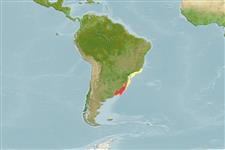Environment: milieu / climate zone / depth range / distribution range
Écologie
marin démersal. Subtropical; 9°S - 37°S
Southwest Atlantic: southern Brazil to southern Argentina.
Taille / Poids / Âge
Maturity: Lm ? range ? - ? cm
Max length : 60.0 cm TL mâle / non sexé; (Ref. ); common length : 40.0 cm TL mâle / non sexé; (Ref. 6077)
Épines dorsales (Total): 5 - 6; Rayons mous dorsaux (Total): 33; Épines anales 3; Rayons mous anaux: 33 - 41; Vertèbres: 27. First dorsal fin composed of several short spines preceded by an anteriorly directed spine usually completely embedded under skin. Two detached anal spines anterior to soft anal fin. Lateral line curved and undulated, with more or less 10 branches anteriorly and fairly straight posteriorly (Ref. 27363). A black patch on the opercle is a conspicuous character of this species, thus the name signata (Ref. 3157).
Maximum length assumed to be 1.5 * 40 = 60 cm TL (RF).
Life cycle and mating behavior
Maturité | Reproduction | Frai | Œufs | Fécondité | Larves
Robins, C.R., R.M. Bailey, C.E. Bond, J.R. Brooker, E.A. Lachner, R.N. Lea and W.B. Scott, 1991. World fishes important to North Americans. Exclusive of species from the continental waters of the United States and Canada. Am. Fish. Soc. Spec. Publ. (21):243 p. (Ref. 4537)
Statut dans la liste rouge de l'IUCN (Ref. 130435)
Menace pour l'homme
Harmless
Utilisations par l'homme
Pêcheries: intérêt commercial mineur
Plus d'informations
Noms communsSynonymesMétabolismePrédateursÉcotoxicologieReproductionMaturitéFraiRassemblement de ponteFéconditéŒufsDéveloppement de l'œuf
Outils
Articles particuliers
Télécharger en XML
Sources Internet
Estimates based on models
Preferred temperature (Ref.
123201): 11.3 - 22, mean 19.3 °C (based on 75 cells).
Phylogenetic diversity index (Ref.
82804): PD
50 = 1.0000 [Uniqueness, from 0.5 = low to 2.0 = high].
Bayesian length-weight: a=0.01047 (0.00482 - 0.02276), b=2.92 (2.74 - 3.10), in cm total length, based on LWR estimates for this (Sub)family-body shape (Ref.
93245).
Niveau trophique (Ref.
69278): 3.4 ±0.45 se; based on food items.
Résilience (Ref.
120179): Milieu, temps minimum de doublement de population : 1,4 à 4,4 années (Assuming tm>=2).
Fishing Vulnerability (Ref.
59153): Moderate vulnerability (44 of 100).
Climate Vulnerability (Ref.
125649): High to very high vulnerability (75 of 100).
Nutrients (Ref.
124155): Calcium = 82.5 [51.3, 199.0] mg/100g; Iron = 1.55 [0.91, 3.06] mg/100g; Protein = 19.4 [17.7, 21.2] %; Omega3 = 0.37 [0.24, 0.61] g/100g; Selenium = 32.6 [17.9, 64.8] μg/100g; VitaminA = 12.1 [3.9, 34.2] μg/100g; Zinc = 0.637 [0.443, 0.914] mg/100g (wet weight); based on
nutrient studies.
